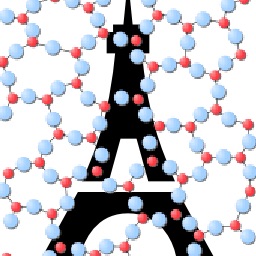Nanoscale structure of cement: viewpoint of rigidity theory
Rigidity theory is a powerful tool to predict the properties of glasses with respect to composition. By reducing such molecular networks to simple mechanical trusses, topological constraint theory filters out all the unnecessary details that ultimately do not affect macroscopic properties. However, the usual constraint enumeration is restricted to networks that are amorphous, homogeneous, and fully connected. On the contrary, calcium−silicate−hydrate (C− S−H), the binding phase of cement, is partially crystalline and heterogeneous and shows some isolated water molecules. Here, we report how rigidity theory can be used to describe the nanoscale structure of this material by relying on molecular dynamics simulations. The distinction between intact and broken constraints is clearly defined at the atomic scale, thus allowing a precise enumeration of the topological constraints. We show that the rigidity of the C−S−H network can be increased by decreasing the Ca/Si molar ratio, which, as predicted by rigidity theory, allows improvement of the hardness of the material. This study suggests that rigidity theory could be applied with great rewards to a broader range of materials than glasses.
